As an Amazon Associate I earn from qualifying purchases.

Corning venison began as one of those, “why not?” experiments that turned out far better than I had expected. I don’t know why I was so worried — I like corned beef, and how different is venison, anyway?
Corning venison at home is so good in fact that any deer hunter out there really ought to learn this technique — you will get far more enjoyment out of the leg roasts from your venison.
I typically use whole-muscle roasts from the hind leg to do this. Big sirloin roasts, rump roasts, the “football roast,” and such. But any big hunk of venison will work. The advantage of the whole-muscle roasts is less sinew and connective tissue, which takes hours to break down. I suppose you could use the backstrap, but why would you?
Lovers of hash might want to corn shoulder or neck roasts, then simmer them so long they begin to fall apart. The extra connective tissue in these cuts makes for a moister hash.

The technique is simple: Brine your meat, then simmer it into tenderness. It takes several days, but it isn’t labor-intensive at all. Once made, corned venison is great hot or cold, with root vegetables, cabbage, cold in sandwiches (how I eat most of my corned venison), or chopped into hash.
A word on nitrites. I use them, for color, for flavor and for safety. Can you do this without pink salt? Yes, but your meat will be gray, you will lose some flavor, and there is an ever-so slight chance you might pick up botulism — not a large chance, but as botulism is one of the most toxic substances known to man, I’d say use the nitrite. You can buy it online here at The Sausage Maker.
Once made, you can keep corned venison in the fridge for a couple weeks, or freeze it for a year.
Corned Venison
Ingredients
- 1/2 gallon water
- 1/2 cup kosher salt
- 1/3 cup sugar
- 1/2 ounce Instacure No. 1 (sodium nitrite)
- 1 tablespoon cracked black pepper
- 1 tablespoon toasted coriander seeds
- 6 bay leaves, crushed
- 1 tablespoon mustard seeds
- 1 tablespoon dried thyme
- 1 teaspoon caraway seeds
- 1 cinnamon stick
- 5 chopped garlic cloves
- A 3 to 5 pound venison roast
Instructions
- Add everything but the roast to a pot and bring it to a boil. Turn off the heat and cover, then let it cool to room temperature while covered. This will take a few hours. Meanwhile, trim any silverskin you find off the roast. Leave the fat. Once the brine is cool, find a container just about large enough to hold the roast, place the meat inside and cover with the brine. You might have extra, which you can discard.
- Make sure the roast is completely submerged in the brine; I use a clean stone to weigh the meat down. You can also just flip the meat every day. Cover and put in the fridge for 5 to 7 days, depending on the roast's size. A 2-pound roast might only need 4 days. The longer you soak, the saltier it will get -- but you want the salt and nitrate to work its way to the center of the roast, and that takes time. Err on extra days, not fewer days.
- After the alloted time has passed, you have corned venison. To cook and eat, rinse off the meat, then put the roast in a pot just large enough to hold it and cover with fresh water. You don't want too large a pot or the fresh water will leach out too much flavor from the meat -- it's an osmosis thing. partially cover the pot and simmer gently -- don't boil -- for at least 3 hours and up to 5 hours. The meat itself will be cooked in an hour or less, but you want the sinews and connective tissue in the roast to soften and that takes time.
- Eat hot or cold. It is absolutely fantastic with good mustard and some sauerkraut on a sandwich.
Notes
Nutrition
Nutrition information is automatically calculated, so should only be used as an approximation.

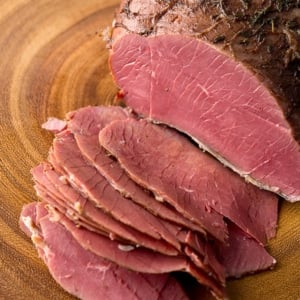
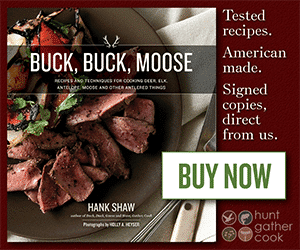

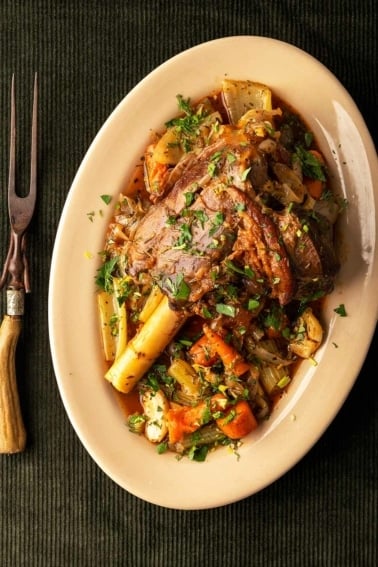
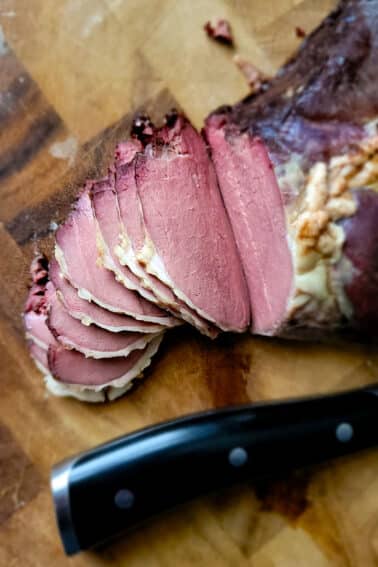
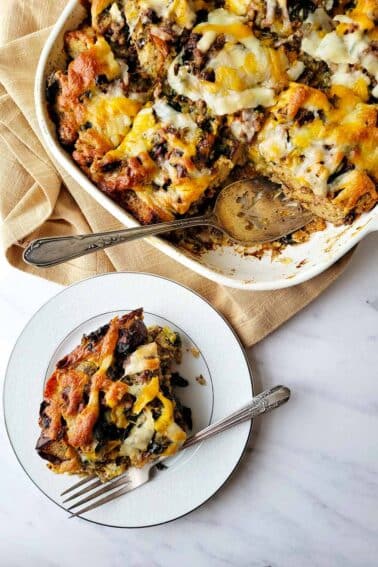
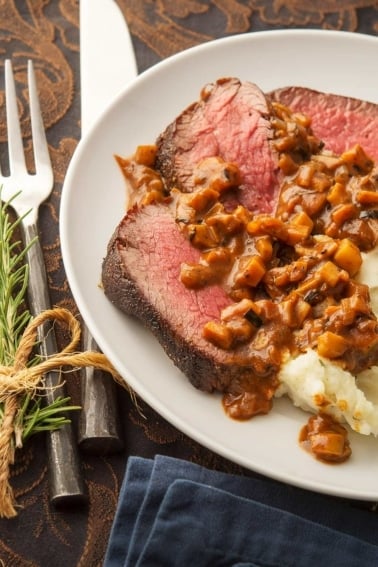
I can’t tell you how glad I am you created this recipe. I’ve made this several times; we’ve had it hot, and we’ve sliced it cold. So very good. And a great way to use those roast cuts from your deer. The only drawback- no fault of yours- is that I have to plan for it a week before I want it!
Holy crap.
I corned every roast on the rear leg of a blacktail buck and only wish I had done the whole back of the beast. The wife and I quickly set about making “Ruben” dishes until we settled upon the holy grail.
My friends, you need to make pan fried breakfast potatoes with corned blacktail butt, sauerkraut, swiss cheese, and homemade 1000 island. Eggs on the side, the rest of the mess stacked on the taters.
Be careful though, the rest of the day can be difficult when it peaks at the start.
Great recipe! I just used two “football ” roasts from this years whitetail for Saint Patrick’s day dinner. This is now a family favorite. Easy and delicious hot or cold, thanks Hank!
I tried this recipie a few years ago, with a pronghorn roast that had been sitting in the freezer for a few years before that. It was my very first forray into cured meat, but the instructions were easy to follow and it turned out great! My hunting buddies were very impressed when I surprised them with corned antelope hash for breakfast at the hunting cabin.
I have made this with both antelope and elk. Outstanding. Only change I made was toasting the pepper and caraway. It was toasting the coriander that inspired me to try toasting the other seeds. Toasting the pepper adds quite a lot for me. Thanks again Hank!
Hank, thanks for the awesome work you do for sharing it with the rest of us. I’ve made your corned venison several times and have a shared the results (and your recipe and website) with family and friends. I tell them if they like corned beef, then they’ll love corned venison. No one has argued.
Hank, how do you think this would work for pastrami (smokeing instesd of boiling). I am worried it would be too salty without the boil.
Michael: If you can wait a week, I am posting my recipe for venison pastrami. Or it’s in my venison cookbook Buck Buck Moose.
Hank…made the corned elk. It turned out excellent. How long can you keep the left overs in the fridge or can it be frozen in the juice. Great recipe
Sandy: You can keep the finished corned venison for a week in the fridge, or freeze it for maybe a year or so.
Does it matter if the meat has already been frozen?
Stephen: Nope, it’ll work fine.
hi hank ive made the corned venison quite a few times have you ever done a pastrami venison ? im thinking about doing it after new year
thanks Rich
In your recipe with the spices in the brine, do you still put pickling spice in the cooking liquid or is that not necessary?
Hey Hank, I love this recipe and do it every year. This year my father-in-law had several elk roasts that I did up for him and he has raved about it. I took a few of the roasts, thin sliced them, vacuum sealed and froze, which seems to work out decently. But I was wondering, do you think that you could pressure can with this recipe? I was thinking, do the normal brine process and then stuff the meat into some jars and then cook in the canner. Just not sure what I’ll end up with. Thoughts?
Zach: Absolutely. You can cure, then they’ll get cooked as you pressure can them.
Can the roast be smoked instead of cooking in water?
Ron: In theory. I’ve never done it though. Try it and let me know how it turns out!
I am using the rear back strap roasts as I have the exceptional and unbelievable almost unlimited access to as much venison as anyone could imagine, as I am currently and have been for 5 years the personal chef for a family of wealthy hunters, will let you know how it turns out 🙂 J.W
We love this recipe so much. If we want to corn all the roasts from all three of our deer, would you suggest freezing them uncorned, then thawing to corn in portions we can eat over the next few weeks? Or corning all of them right off the deer and freezing them after they are boiled?
Amy: I typically corn and then freeze, but either works.
Hank if I wanted to do several roast like this, and then put them in a deep freeze, could I do that? Vacuum seal it with some brine, and then throw it in the freezer?
Gary: I cook them fully and then vac and freeze, then thaw and slice for sandwich meat.
I made this today in the crockpot. Came out great! Will definitely make this again.
My corned venison is in brine and comes out tomorrow. Can I sous vide the venison instead of simmering in water? If so, does it need any liquid in the bag or just rinse, pat, and place in bag? Also what would the temp be if using the sous vide? Thanks.
Logan: Yes you can. Yes, you want a little liquid in there. I’d shoot for an internal temperature of about 140F.
A real family favorite. When the child that doesn’t eat venison loves it, it’s a keeper. Our fourth go at it is simmering on the range as I type and the mouths are already watering……..
I use this recipe to brine wild duck (whole), and swan or goose breasts and legs. Very tasty!